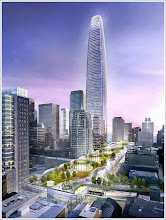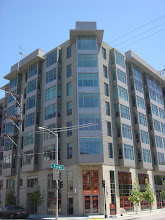When I shopped for my first condominium in San Francisco, one of my "must-haves" was private outdoor space. My terrace measured three by four feet and the door opened out, making most of the floor space unusable. Still, it was wonderful to have a tall clutch of potted bamboo and a perch from which to take in the view, breeze or the 30 minutes of madness after a ball game in Mission Bay.
When my neighbors started storing bicycles, boxes and indoor furniture on their terraces, my lovely new building started to look more like a vertical garbage shelving unit. My favorite item on view for 3 months ? A toilet.
Thankfully, the HOA began enforcing the CC&R's and the terraces were gradually cleaned up. This experience poses the question: What do you do with your small piece of the outdoors in the sky ?
Having successfully created three terrace designs of my own, I'm happy to recommend the following advice:
KISS
Keep it Simple, Silly. Chances are your space is limited. Trying to create an elaborate outdoor room is not in the cards functionally or aesthetically in a small area. Scale your plans accordingly.
The Rule of One
When choosing outdoor furniture and planters, select a single color and style for each. Too much color and variation will make the space appear kitschy when the look you want to achieve is more cohesive and subtle.
Customize
If stock outdoor furniture and planters don't come in sizes suited to the scale of your terrace, have them made.
Commissioning an artisan to design and build custom pieces is not as time consuming or expensive as you may think.
The Bay Area has a large community of talented craftspeople that can create something beautiful, functional and unique--
much better than a milk crate and a beer bottle ashtray.
I Never Promised You a Rose Garden
Lucky as we are to live in San Francisco, it tends to be a bit windy and chilly--not the ideal climate for hot-house orchids or delicately leafed specimens. Select just one or two hardy species such as boxwood or cedar and keep in mind how much sun they will receive. Choosing a plant that is green year-round will create a consistent look that can stand on its own or be enlivened with seasonal color. If your terrace is on a high floor where winds whip, select dense, lower growing plants and don't let them exceed the height of your railing, wind break or parapet wall.
Water Works
Plants need water. Depending on rainfall, temperature and exposure you will need to bring the watering can outside at least 3 days a week. If you plan on being away more than 5 days have someone come by and water. I figured this out when I left town for a week and there was a freak heat wave leaving my plants a healthy shade of brown upon my return. Live and learn.
When a terrace is done well it lends an inviting, finished look to the whole home. It's not that difficult or time consuming and if you are lucky enough to have your own slice of the outdoors in the city; you owe it to yourself to get out there and enjoy it !
Monday, May 4, 2009
Subscribe to:
Comments (Atom)
















































